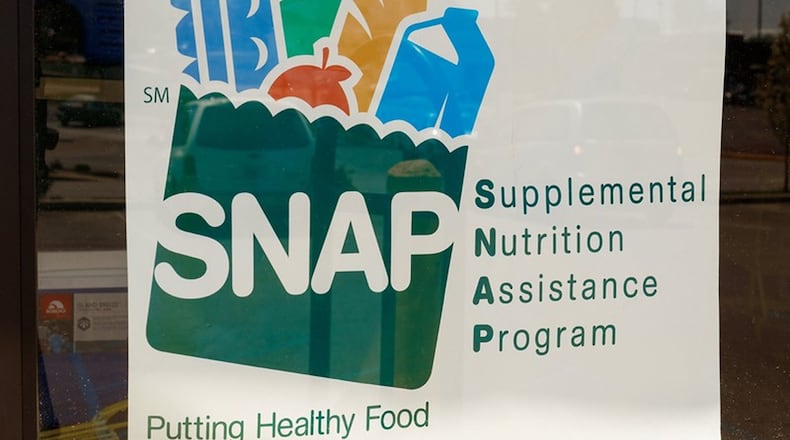The number of households receiving food stamp assistance has held steady for the past year after ballooning by 40% in the first six months after the COVID-19 pandemic hit Georgia.
At the same time, fewer Georgians are receiving welfare benefits this year than last, a downward trend that’s existed for more than a decade as government officials sought to reduce the rolls.
The economy has begun to turn around — with unemployment rates falling and reports showing that some Georgians are comfortable spending disposable income again — but a new variant of COVID-19 could slow that progress.
Instead of seeking help from the welfare program, those experiencing financial hardship have chosen to turn to help from food stamps, where the number of households receiving the benefit has remained much higher than pre-pandemic levels for the past year.
State officials and advocates, meanwhile, say there could be a number of reasons for the decrease in the Temporary Assistance for Needy Families program, commonly known as welfare. The decline of nearly 1,200 households in the past year — despite the pandemic — follows a long trend of fewer and fewer people receiving public cash benefits.
The criteria to qualify for TANF are more strict than for food stamps, according to officials with the Division of Family and Children Services. DFCS administers the state’s food stamp and welfare programs.
Jon Anderson, the head of DFCS’ Office of Family Independence, said the agency doesn’t track why welfare recipients leave the rolls. Recipients have to qualify annually and often, he said, they choose not to seek renewal.
“When they don’t renew at all, they don’t submit paperwork,” he said. “Other people are closing (accounts) because they have increased earnings where they found a job and don’t need this assistance anymore.”
In July 2020, welfare benefits were granted to 8,533 Georgia households, according to DFCS data provided to The Atlanta Journal-Constitution. By June 2021, that number was down to 7,358.
In 2006, the earliest year for which DFCS could provide data, 33,302 households received welfare benefits. That’s a decrease of nearly 78%.
Since Congress passed sweeping changes to the federal welfare program in 1996, the number of households receiving benefits has consistently dropped across Georgia and the country. Changes implemented in the ‘90s gave states more control over how to run welfare, which has long been politically stigmatized.
In Georgia, state officials require welfare recipients to work or participate in training for at least 30 hours each week. Those who sign up get access to job-searching assistance, or, if necessary, they receive help finishing high school, completing a GED program or finding another specialized certification program.
Anderson said some Georgians who begin to sign up for welfare opt not to once they learn about the work requirement, resulting in fewer households receiving benefits.
To assist those who lost their jobs due to the pandemic last year, the federal government approved an additional $600 per week in unemployment benefits, in addition to any state benefits offered. The benefit was cut to $300 last August before Gov. Brian Kemp suspended the program completely in June.
Georgia’s unemployment rate dropped to a recent low of 4% in June from 12.5% in April 2020 — the highest point during the pandemic. And in metro Atlanta, which represents roughly two-thirds of the state’s economy, retail sales last month were 11.9% higher than the same month two years earlier, according to the Mastercard SpendingPulse, which measures in-store and online retail sales.
Donna Pavetti, vice president for family income support with the Center on Budget and Policy Priorities — a left-leaning think tank based in Washington — said people might have been more likely to turn to welfare benefits if the extra federal unemployment benefits weren’t in place. And they may not seek out the benefit due to a federal child tax credit that rolled out last month that gives parents monthly payments of up to $300 per child dependent through the end of the year.
“The other thing that happens in a state like Georgia, where it has a reputation for being a program that is very punitive and has a really high bar for being able to receive assistance, is people don’t want to apply or people don’t know that it exists because the number of people receiving TANF is so tiny,” Pavetti said. “It’s not like (food stamps), where people know that is a program that will be responsive when they hit hard times.”
To be eligible for welfare in Georgia, a family of three must have a gross income below $784 a month. That same family could have a monthly gross income of up to $2,311 and still qualify for benefits from the Supplemental Nutrition Assistance Program, the formal name of the food stamps program.
According to DFCS data, there were about 876,000 households receiving almost $465 million in SNAP benefits in July 2020. By this past March, the most recent month for food stamp figures made available by DFCS, about 848,000 households were receiving about $387 million in benefits.
Food stamp participation has yo-yoed throughout the pandemic. Enrollment swelled from about 627,000 in February 2020 to nearly 912,000 households that September. Enrollment decreased to about 819,000 households in December, which officials say is caused by lags in recipients reapplying for the annual benefit. Enrollment has steadily increased since then.
The average monthly benefit also increased by nearly $100 per household since pre-pandemic figures, due to the state increasing the amounts recipients could receive because of the pandemic.
Historically, “work requirements” across several Georgia counties for people state officials identified as “able-bodied adults without dependents” led to shrinking the state’s food stamp rolls. About 600,000 fewer people received food stamps in 2019 than in 2013.
The federal work rules require adults between the ages of 18 and 49 who are not disabled and who have no dependents to work at least 20 hours a week or be engaged in some sort of education or work training. Those classified as able-bodied adults with no children get three months to find a job or training program, or they lose their benefits.
Georgia officials were expected to implement the work requirements statewide by April 2020, but they abandoned those plans once the pandemic hit and waived the requirement completely. DFCS recently applied to waive the enforcement of work requirements through July 2022.
“We will keep on our programs as long as there’s a need for assistance to help people with COVID recovery,” Anderson said. “DFCS will do everything we can to help families quickly get to where thy need to be.”
Households receiving food stamps in Georgia:
June 2013: 910,610
June 2016: 787,527
July 2019: 632,180
June 2020: 847,981
September 2020: 911,938
March 2021: 847,672*
Households receiving welfare benefits in Georgia:
June 2013: 16,832
June 2016: 12,296
July 2019: 9,165
June 2020: 8,346
June 2021: 7,358
Source: Georgia Division of Family and Children Services, *most recent numbers available
About the Author
Keep Reading
The Latest
Featured





